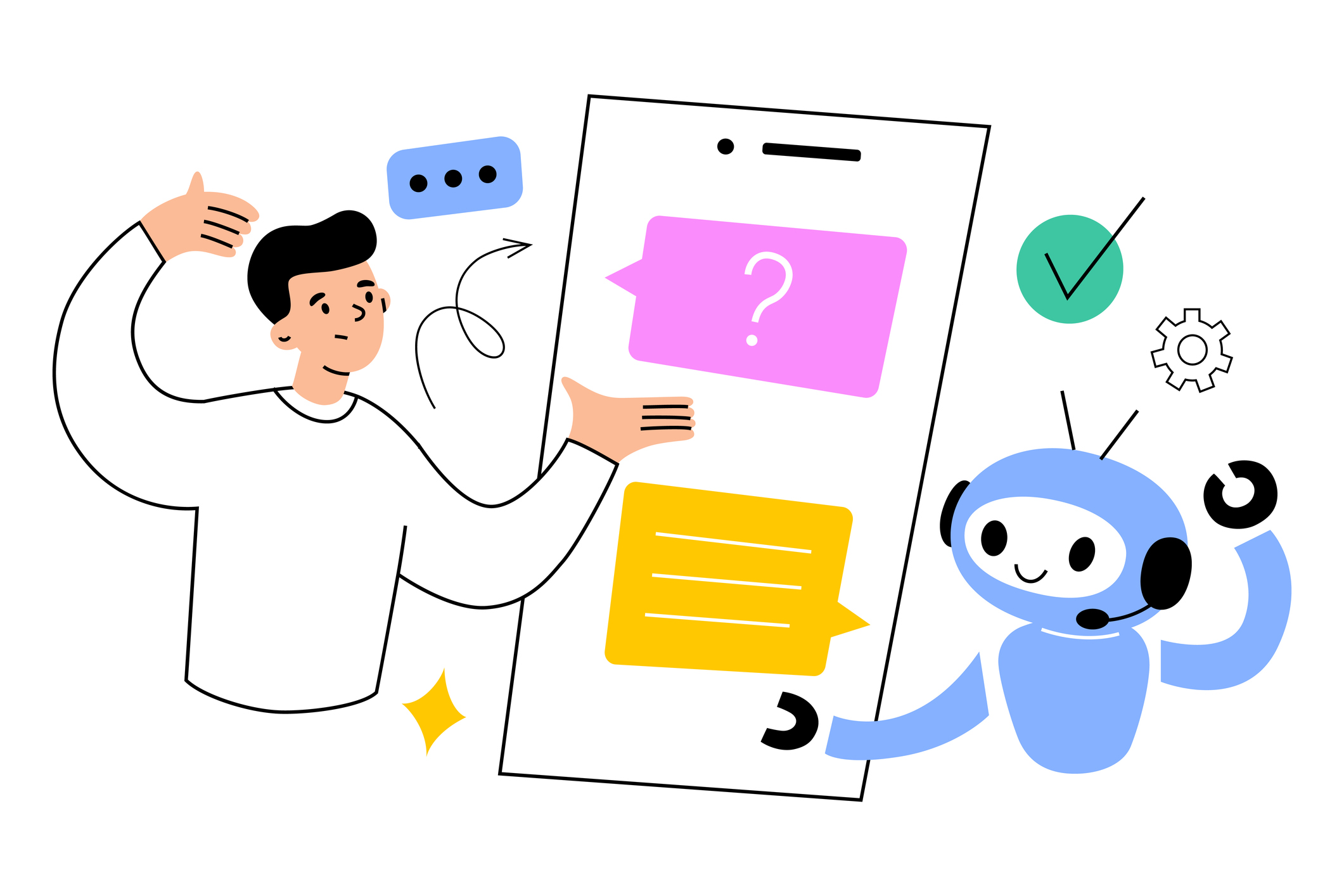Featured
Smart IVR: Benefits, Use Cases & More
by Kent Mao | Published On May 31, 2024

Advancements in artificial intelligence have led to a new era for IVR technology. Is it time for your business to upgrade to a Smart IVR system?
IVR technology, which stands for “interactive voice response,” has been around for decades. But as artificial intelligence evolves, these automated phone systems are being transformed.
Today, Smart IVR systems are leveraging artificial intelligence (AI) and machine learning to help companies optimize customer experiences, improve productivity, and reduce costs.
Here’s everything you need to know about Smart IVR systems and how they work, their use cases, and their many benefits.
What is Smart IVR?
A Smart IVR system is an enhanced version of the traditional IVR phone system, which is used to automate customer interactions. The term "Smart IVR" is often used interchangeably with "Intelligent IVR" and "Conversational IVR".
Chances are you’re familiar with traditional IVR phone systems. If you’ve ever called a business and heard an automated system say “Press 1 for…”, then you already know how an IVR system works.
Smart IVR systems still allow callers to access self-service options and help direct them to the appropriate departments or agents. However, Smart IVR systems allow callers to interact using their voice instead of their keypad.
Smart IVRs leverage other modern technologies too, such as artificial intelligence, predictive analytics, speech recognition, and natural language processing, to provide a better user experience.
By using a Smart IVR system, companies can enhance the customer journey, accelerate issue resolution, and automate various processes. Some Smart IVR systems can even reach out to customers proactively, delivering automated messages about technical issues, product updates, special offers, and more.
The History and Evolution of IVR Systems
Interactive voice response (IVR) systems have been a fundamental part of call center operations for decades. The earliest IVR systems date back to the early 1970s, when they first emerged as a revolutionary technology for automating telephony tasks.
These initial systems were rudimentary but provided a significant efficiency boost for businesses by automating routine inquiries and transactions.
By the 1980s and 1990s, advances in computer telephony integration (CTI) and speech recognition technologies expanded the capabilities of IVR systems, allowing for more complex interactions and broader applications across various industries. The 2000s saw further improvements with the integration of more sophisticated speech recognition and natural language processing, making IVR systems more user-friendly and efficient.
Today, the evolution of artificial intelligence and machine learning has given rise to Smart IVR systems, which offer personalized, context-aware, and highly efficient customer service experiences, marking a significant leap from their humble beginnings.
With Smart IVR, customers can interact with an IVR menu using natural language and the system can understand the words spoken, allowing it to route calls more effectively, answer questions with natural language generation, and complete a range of tasks.
How Smart IVR Works

Smart IVR systems leverage natural language processing (NLP) and artificial intelligence (AI) to provide a more intuitive and human-like interaction for callers. Here's how it works:
- Voice input: Instead of pressing numbers on the phone, the caller speaks their request or responds to prompts using their voice.
- Speech recognition: The IVR system uses automatic speech recognition (ASR) technology to convert the caller's spoken words into text. The system filters out background noise and non-essential words to focus on the caller's main intent.
- Natural language processing (NLP): The converted text is processed using NLP algorithms to understand the caller’s intent and context.
- Intent recognition: The system matches the caller's input to predefined intents within its database. For example, intents might include "check account balance," "speak to an agent," or "reset password." This process leverages natural language understanding (NLU) technology and machine learning models to improve the accuracy over time.
- Response generation: Based on the recognized intent, the IVR system generates a response using a human-like voice or pre-recorded message.
Key Features of a Smart IVR System
The features of your Smart IVR system can vary depending on your chosen vendor. However, the most important elements of any Smart IVR include:
Voice and Speech Recognition
For an IVR system to be able to interact with callers, it must understand their needs. Traditional IVR systems use dial tones to define customer requests. Smart IVR systems, on the other hand, usually rely on automated speech recognition (ASR), which allows the systems to understand spoken commands.
This allows customers to interact with your IVR menu by voicing their requests, rather than using a dial pad. This can help decrease the time it takes for customers to resolve their issues and reduce the risk of calls being handled or routed incorrectly.
Some Smart IVR vendors even embed biometric technology into their solutions, which allows companies to authenticate customers based on their voice alone.
Conversational AI
Conversational AI refers to technologies that enable machines to understand, process, and respond to human language in a natural and intelligent way. It combines several fields of artificial intelligence and machine learning, to create systems that can interact with users in a human-like manner.
Conversational AI technology allows your Smart IVR system to formulate responses using a simulated voice, or play recordings based on what they learn from a customer’s request. Essentially, this technology is what allows customers to have a human-like conversation with your IVR system.
Predictive Analytics
Smart IVRs allow companies to optimize the flow of calls based on various routing strategies. Some solutions give companies the freedom to build their own routing workflows, which inform the system how it should distribute calls. For example, you might decide to route calls based on agent experience or skill, data about your customer taken from a CRM, or agent availability.
With built-in machine learning and analytical capabilities, a Smart IVR system can also assess the data from your contact center to route calls predictively. This means the system analyzes agent, customer, and interaction data, to determine how to route calls in the most efficient way.
For example, Smart IVRs can greet customers by name, provide relevant menu options based on their past queries, or route them directly to their preferred agent or department.
Integrations with Call Center Tools
Smart IVR systems need to be able to integrate with the tools in your call center to access data and make intelligent decisions that enhance the customer experience. Aside from integrating with your contact center software, Smart IVRs can usually connect to other tools such as appointment scheduling systems, workforce management applications, and payment processing systems.
One of the most important tools your Smart IVR should integrate with is your CRM software. Integrating with this software allows your Smart IVR system to access data about previous customer interactions – such as purchase history – so you can give your callers a more personalized experience.
Common Use Cases for Smart IVR
The use cases for your smart IVR system can vary depending on the solution you choose. For instance, if you purchase an IVR solution that supports outbound campaign management, you could use it to deliver proactive messaging to customers or enhance your marketing campaigns.
In general, Smart IVR systems are deployed for three common use cases:
Enabling Self-Service
One of the core purposes of any IVR system is to enable self-service for callers. However, Smart IVR systems take the self-service capabilities of the traditional IVR to the next level. Due to their advanced AI technology, Smart IVR systems can automate a wide range of tasks across many different industries.
- Banking and financial services: Smart IVRs can help customers access account information, pay bills, and make banking transactions with built-in payment processing capabilities. They can also notify customers about suspicious activities on their accounts and allow them to take immediate action.
- Healthcare: When deployed by hospitals and medical clinics, Smart IVRs can help patients book, confirm, reschedule, or cancel appointments on their own. They can also assist patients with requesting prescription refills and getting information about their medications. While still in the early stages, Smart IVRs may soon be able to provide general information about medical conditions, treatments, and other services offered by healthcare providers.
- Retail and e-commerce: Smart IVRs can even allow customers to place orders, check the status of a current order, and make changes to their account. Plus, Smart IVR systems can draw information from a range of environments to answer frequently asked questions about everything from refund and return policies to business operating times, helping to reduce the number of common queries your agents have to deal with.
Intelligent Call Routing
Compared to traditional IVRs, Smart IVRs facilitate more effective call routing, giving companies more freedom over how they direct callers in their queue. Using AI technology, a Smart IVR system can understand a customer’s reason for calling by analyzing their intent. The system can then determine how to route the call based on their specific needs.
Smart IVRs can also leverage data from other solutions – like your CRM system and employee directory – in order to make more strategic decisions. Using this data, the IVR system can route customers to the same agent they spoke to before or send them to an agent with specific knowledge or skills to handle the query.
Some Smart IVR solutions can even offer customers call-back options when they detect call volumes are high. Smarter call routing leads to shorter wait times, lower abandonment rates, happier customers, and more effective resource allocation.
Automating Critical Tasks
Self-service isn’t the only thing a Smart IVR system can help automate. Smart IVRs can also streamline many other critical processes in your contact center. For example, these systems can track and report on the journey of every call and upload this valuable information to your CRM database.
Smart IVRs with outbound calling capabilities can automate the process of reaching out to customers with updates, product information, or appointment reminders. Many Smart IVR solutions can even automate the process of collecting customer feedback to help you learn more about your target audience.
These systems can help conduct post-call surveys automatically, asking questions about your customer’s experience and storing the data for later analysis. This can help improve the efficiency of your call center, by reducing operational costs and eliminating repetitive work for agents.
The Benefits of Smart IVR for Call Centers

A Smart IVR system takes all the advantages of a traditional IVR system to the next level by infusing your phone technology with powerful AI algorithms. With the right Smart IVR solution, you’ll be able to accomplish more with less and unlock the following benefits:
Improved Customer Experience
Smart IVR systems improve the customer experience in a range of different ways. They allow you to interact with your customers and answer their questions faster, while enabling callers to access self-service options 24/7.
A well-designed IVR system also helps callers to avoid long wait times and frustrating interactions. Customers can use self-service options to address common queries and access necessary information, and ensure they reach the right department or agent straight away when they need human support.
Because Smart IVRs optimize the routing process, they also improve first contact resolution times by boosting your chances of sending your callers to the best possible agent to address their needs. All of this leads to happier callers, better customer retention, and even boosted sales.
Cost Savings and Efficiency
Smart IVR systems can help improve the operational efficiency of your contact center. By optimizing call routing using predictive analytics, Smart IVRs can reduce call durations, help agents handle more calls, and minimize call transfers.
Smart IVRs can also support agents with everything from collecting data and post-call feedback to automating processes and managing common customer queries. This allows your employees to spend less time on repetitive, tedious tasks and more time on tasks that require creativity or complex thinking.
Not only does this lead to higher employee satisfaction rates, but it can help reduce operational costs too. Happier employees equals less money spent on hiring and onboarding new agents. Plus, a more productive team means you can accomplish more with fewer employees, resulting in lower overhead costs.
Enhanced Data Collection and Insights
Smart IVRs are excellent at collecting valuable data about your customers’ goals, needs, and common challenges. Intelligent solutions can track the journey of every call, giving you behind-the-scenes insights into common customer concerns and pain points.
Smart IVR systems can store this information and help analyze it to uncover common trends and patterns. Analyzing this data can help you make intelligent scheduling and staffing decisions, prepare for peaks in call volume, and enhance your customer self-service strategies.
In addition, with the ability to automatically conduct surveys and collect feedback from customers, Smart IVR solutions can give you better insight into the customer experience. All this leads to making more intelligent decisions on how to improve customer engagement, retention, and conversion rates.
Drawbacks of Smart IVR Systems
While Smart IVR systems offer numerous benefits, they also come with certain drawbacks:
- Complexity and cost: Implementing Smart IVRs can be costly and resource-intensive due to the advanced technology required.
- Lack of human touch: Smart IVR systems can feel impersonal, leading to frustration for customers who prefer interacting with a live person. Although text-to-speech voice technology is improving every day, Smart IVR systems can still sound robotic in some instances.
- Misinterpretation: Despite advances in NLP, Smart IVR systems may still misinterpret user input, especially with accents, dialects, and background noise. This can lead to frustration for users who must repeat themselves or are incorrectly interpreted.
- Technical limitations: The effectiveness of Smart IVRs depends on the quality of the underlying technology. Limitations in speech recognition and AI technology can impact performance. Users may also find Smart IVR systems confusing or unintuitive.
- Limited applications: While Smart IVRs are improving, they may still struggle with handling highly complex or nuanced inquiries. In such cases, users may need to be transferred to live agents, which negates some of the efficiency benefits.
By being aware of these drawbacks, organizations can better plan and implement Smart IVRs to minimize potential issues and maximize their benefits.
Ready to Upgrade your Call Center with Smart IVR?
IVR systems will always be a crucial part of call centers. However, in today’s fast-paced environment, traditional IVRs can only accomplish a fraction of the results offered by a smart system.
With a Smart IVR, you can optimize your customer’s’ journey through every touchpoint, personalize your caller interactions, and improve overall efficiency and productivity. Plus, you’ll gain the insights you need to make intelligent decisions, reduce operational costs, and ensure that your agents can focus on more complex and high-value tasks.
Schedule a call with a ComputerTalk expert to discover how a Smart IVR solution can transform your call center.
More from our blog
 In the healthcare space, contact centers are crucial to bridging the gap between service providers and patients seeking support, information, or guidance.
In the healthcare space, contact centers are crucial to bridging the gap between service providers and patients seeking support, information, or guidance.
 Here at ComputerTalk, we are wrapping up our fiscal year and getting ready to start fiscal 2025 at the beginning of June. During this time, we are reflecting on all the exciting things we’ve achieved throughout the last year and...
Here at ComputerTalk, we are wrapping up our fiscal year and getting ready to start fiscal 2025 at the beginning of June. During this time, we are reflecting on all the exciting things we’ve achieved throughout the last year and...
 While voice has been the channel traditionally associated with call centers for years, many modern contact centers have now evolved to include webchat capabilities.
While voice has been the channel traditionally associated with call centers for years, many modern contact centers have now evolved to include webchat capabilities.

